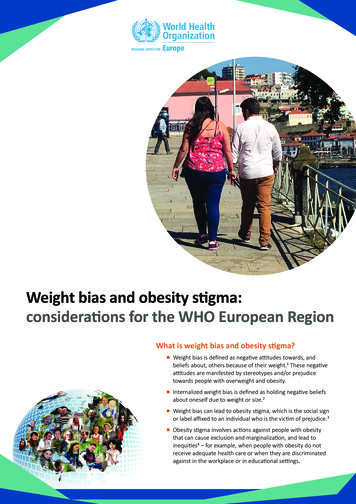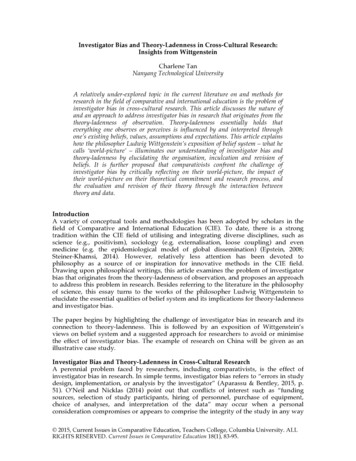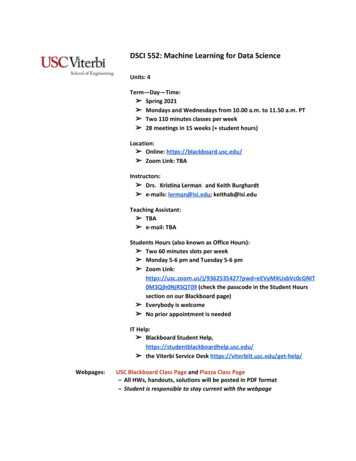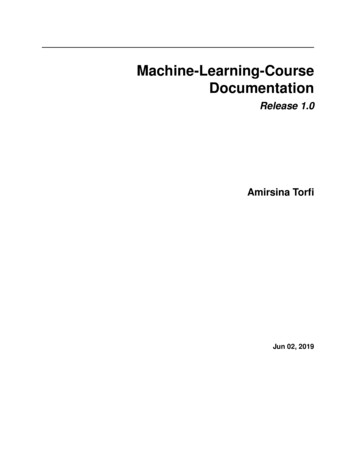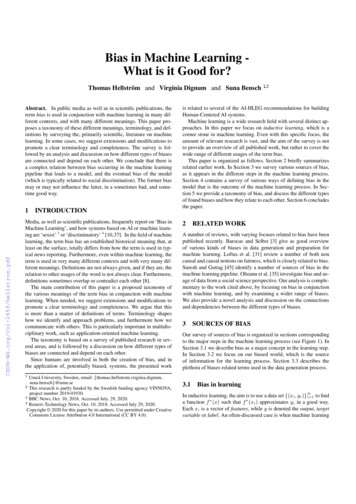
Transcription
Bias in Machine Learning What is it Good for?Thomas Hellström and Virginia Dignum and Suna Bensch 1,2Abstract. In public media as well as in scientific publications, theterm bias is used in conjunction with machine learning in many different contexts, and with many different meanings. This paper proposes a taxonomy of these different meanings, terminology, and definitions by surveying the, primarily scientific, literature on machinelearning. In some cases, we suggest extensions and modifications topromote a clear terminology and completeness. The survey is followed by an analysis and discussion on how different types of biasesare connected and depend on each other. We conclude that there isa complex relation between bias occurring in the machine learningpipeline that leads to a model, and the eventual bias of the model(which is typically related to social discrimination). The former biasmay or may not influence the latter, in a sometimes bad, and sometime good way.1INTRODUCTIONMedia, as well as scientific publications, frequently report on ‘Bias inMachine Learning’, and how systems based on AI or machine learning are ‘sexist’ 3 or ‘discriminatory’ 4 [10,37]. In the field of machinelearning, the term bias has an established historical meaning that, atleast on the surface, totally differs from how the term is used in typical news reporting. Furthermore, even within machine learning, theterm is used in very many different contexts and with very many different meanings. Definitions are not always given, and if they are, therelation to other usages of the word is not always clear. Furthermore,definitions sometimes overlap or contradict each other [8].The main contribution of this paper is a proposed taxonomy ofthe various meanings of the term bias in conjunction with machinelearning. When needed, we suggest extensions and modifications topromote a clear terminology and completeness. We argue that thisis more than a matter of definitions of terms. Terminology shapeshow we identify and approach problems, and furthermore how wecommunicate with others. This is particularly important in multidisciplinary work, such as application-oriented machine learning.The taxonomy is based on a survey of published research in several areas, and is followed by a discussion on how different types ofbiases are connected and depend on each other.Since humans are involved in both the creation of bias, and inthe application of, potentially biased, systems, the presented workis related to several of the AI-HLEG recommendations for buildingHuman-Centered AI systems.Machine learning is a wide research field with several distinct approaches. In this paper we focus on inductive learning, which is acorner stone in machine learning. Even with this specific focus, theamount of relevant research is vast, and the aim of the survey is notto provide an overview of all published work, but rather to cover thewide range of different usages of the term bias.This paper is organized as follows. Section 2 briefly summarizesrelated earlier work. In Section 3 we survey various sources of bias,as it appears in the different steps in the machine learning process.Section 4 contains a survey of various ways of defining bias in themodel that is the outcome of the machine learning process. In Section 5 we provide a taxonomy of bias, and discuss the different typesof found biases and how they relate to each other. Section 6 concludesthe paper.2RELATED WORKA number of reviews, with varying focuses related to bias have beenpublished recently. Barocas and Selbst [3] give as good overviewof various kinds of biases in data generation and preparation formachine learning. Loftus et al. [31] review a number of both noncausal and causal notions on fairness, which is closely related to bias.Suresh and Guttag [45] identify a number of sources of bias in themachine learning pipeline. Olteanu et al. [35] investigate bias and usage of data from a social science perspective. Our analysis is complementary to the work ci
by Tom Mitchell in his paper from 1980 with the title The Need for Biases in Learning Generalizations [34], and is a central concept in statistical learning theory. The expression inductive bias (also known as learning bias) is used to distinguish it from other types of biases. In general, inductive learning can be expressed as the minimiza .

